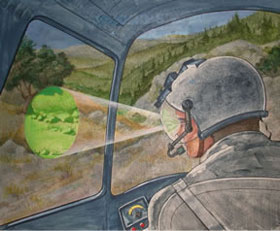|
|
 |

|
 |
 |
 Electro-optical imaging systems are being introduced into military and civilian operation allowing pilots to fly at very low levels, to avoid obstacles in reduced visibility, and to maintain geographical orientation. These systems transduce energy that is normally not perceptible to the human visual system into a viewable image on a display. Such systems include infrared imagery (thermal energy), night vision goggles (intensified visible light), and passive millimeter wave sensors. However, pilots are generally not able to achieve the same performance levels as with direct vision in daylight conditions. Despite the problems pilots are encountering with recently fielded systems, surprisingly little information is available about human capabilities and limitations with these devices. Electro-optical imaging systems are being introduced into military and civilian operation allowing pilots to fly at very low levels, to avoid obstacles in reduced visibility, and to maintain geographical orientation. These systems transduce energy that is normally not perceptible to the human visual system into a viewable image on a display. Such systems include infrared imagery (thermal energy), night vision goggles (intensified visible light), and passive millimeter wave sensors. However, pilots are generally not able to achieve the same performance levels as with direct vision in daylight conditions. Despite the problems pilots are encountering with recently fielded systems, surprisingly little information is available about human capabilities and limitations with these devices.
Human Factors researchers have been conducting research in this area with NASA funding. The overall goals of the Night Vision Devices research are to: (1) Determine the critical human factors issues associated with pilots' military and civil use of night vision devices such as night vision goggles (NVGs) and infrared (IR) sensors, (2) Conduct field studies and simulation research to determine pilots' capabilities and problems related to both military and civil use of night vision devices, (3) Identify and evaluate potential technological solutions for identified problems, and (4) Create a knowledge base of relevant research to allow for informed decisions to be made in certifying night vision devices for military and civil use.
Another goal of this research is to contribute to improved system specifications and training requirements by identifying and studying the most significant human factors problems. Problems associated with image quality (e.g., contrast, resolution, field of view, signal/noise ratio) reflect hardware limitations which are likely to be improved, but not solved, in the foreseeable future. The offset sensor location and changes in relative contrasts, shadowing and shading inherent in all night vision devices create another class of problems. Research has been carried out to identify attentional problems and distortions in motion perception and range estimation caused by an offset eye point. Laboratory and simulation research is being conducted to identify the perceptual and cognitive costs and benefits of monocular and binocular display formats. While the monocular display format used in the infrared systems leaves the unaided eye "free" to view peripheral motion cues and cockpit instruments and to verify the identity of objects directly, differences in information available to the two eyes may create binocular rivalry; pilots must selectively focus their attention on one visual field or simultaneously process different visual images. Surprisingly, initial results suggest that people can use their eyes as separate information channels, selectively focusing their attention on information presented to either eye. However, they have difficulty dividing their attention between two (different) visual fields.
Simulation research has been performed to evaluate pilots' abilities to fly using a monocular helmet display while monitoring panel displays or a projected visual scene with the other eye, as well as with stereoscopic displays. A series of studies have been conducted to identify the characteristics of thermal images that contribute most to the problems pilots are encountering. Simulation research will compare performance with simulated out-the-window and infrared imagery to further investigate the relative importance of display parameters. A knowledge base of relevant research to allow for informed decisions to be made in certifying night vision devices for civil use will be created.
Go to: Enhanced Vision Publications Available for Download |
|
|